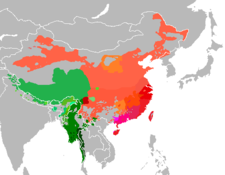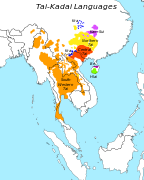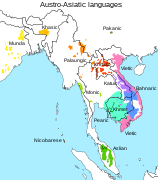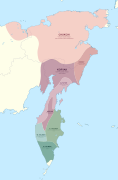Languages of East Asia
This article needs additional citations for verification. (June 2009) |
The languages of ), though in the first two the use of Chinese characters is now restricted to university learning, linguistic or historical study, artistic or decorative works and (in Korean's case) newspapers, rather than daily usage.
Language families
The Austroasiatic languages include Vietnamese and Khmer, as well as many other languages spoken in areas scattered as far afield as Malaya (Aslian) and central India (Korku), often in isolated pockets surrounded by the ranges of other language groups. Most linguists believe that Austroasiatic languages once ranged continuously across southeast Asia and that their scattered distribution today is the result of the subsequent arrival of other language groups.[1]
One of these groups were the
The
The Austronesian languages are believed to have spread from Taiwan to the islands of the Indian and Pacific Oceans, as well as some areas of mainland southeast Asia.[4]
The varieties of Chinese are usually included in the Sino-Tibetan family, which also includes Tibeto-Burman languages spoken in Tibet, southwest China, northeast India, Burma and neighbouring countries.
To the north are the
Chinese scholars often group Tai–Kadai and Hmong–Mien with Sino-Tibetan, but Western scholarship since the Second World War has considered them as separate families. Some larger groupings have been proposed, but are not widely supported. The
Mainland Southeast Asia linguistic area
The Mainland Southeast Asia
Characteristic of many MSEA languages is a particular syllable structure involving
A well-known feature is the similar tone systems in Chinese, Hmong–Mien, Tai languages and Vietnamese. Most of these languages passed through an earlier stage with three tones on most syllables (apart from
MSEA languages tend to have monosyllabic morphemes, though there are exceptions.
Languages of both eastern and southeast Asia typically have well-developed systems of
Influence of Literary Chinese
For most of the pre-modern period, Chinese culture dominated East Asia. Scholars in Vietnam, Korea and Japan wrote in
Today, these words of Chinese origin may be written in the
In a similar way to the use of
Topic–comment constructions
In
- Chinese
|
Classical Chinese example:
|
Cantonese example:
Hokkien example:
Shanghainese example:
| |||||||||||||||||||||||||||||||||||||||||||||||||||||||||||||||||||||||||||||||||||||||||||||||||||||||||||||||||||||||||||||||||||||||||||||||||||||
- Japanese
|
Japanese example:
The epistolary style of Japanese (Sōrōbun) example:
|
The Standard Meiji-Era Written Style of Japanese (Meiji Futsūbun) example:
| ||||||||||||||||||||||||||||||||||||||||||||||||||||||||||||||||||||||||||||||||||||
- Korean
|
Korean example:
|
Korean mixed script example:
| ||||||||||||||||||||||||||||||||||||||||||||||||||||||||
- Ryukyuan
Okinawan Ryukyuan example:
| 今日 | ぬ | 夕御飯ー | なー | 噛だん。 | ||
| Transcription: | Chuu | nu | yuu'ubanoo | naa | kadan. | |
| Gloss: | today | GENITIVE | dinner-TOPIC | already | eat-PERFECTIVE | |
| Translation: | I've already eaten today's dinner. (Topic: today's dinner; Comment: already eaten.) | |||||
Note that in Okinawan, the topic marker is indicated by lengthening the short vowels and adding -oo to words ending in -N/-n. For words ending in long vowels, the topic is introduced only by や.
- Vietnamese
Vietnamese example:
| Hôm nay | tôi | đã | ăn | bữa ăn tối. | ||
| Chữ Nôm: | 𣋚𠉞 | 碎 | 吔 | 𩛖 | 𩛷𩛖啐。 | |
| Gloss: | today | I | already | eat | dinner | |
| Translation: | I've already eaten today's dinner. | |||||
Politeness systems
Linguistic systems of
In many of the region's languages, including Japanese, Korean, Thai, and Malay/Indonesian, new
With modernization and other trends, politeness language is evolving to be simpler. Avoiding the need for complex polite language can also motivate use in some situations of languages like Indonesian or English that have less complex respect systems.[citation needed]
Distribution maps
-
Distribution of Sino-Tibetan languages
-
Distribution of Kra–Dai languages
-
Distribution of Austroasiatic languages
-
Distribution of Hmong–Mien languages
-
Dispersal of Austronesian languages
-
Distribution of Koreanic languages
-
Distribution of Japonic languages
-
Distribution of Ainu languages
-
Distribution of Nivkh languages
-
Distribution of Chukotko-Kamchatkan languages
See also
- EALC
References
Citations
- ^ Sidwell & Blench (2011), pp. 339–340.
- ^ Ramsey (1987), p. 233.
- ^ Ramsey (1987), pp. 278–279.
- ^ Diamond (2000).
- ^ "While 'Altaic' is repeated in encyclopedias and handbooks most specialists in these languages no longer believe that the three traditional supposed Altaic groups, Turkic, Mongolian and Tungusic, are related." Lyle Campbell & Mauricio J. Mixco, A Glossary of Historical Linguistics (2007, University of Utah Press), pg. 7.
- ^ Norman (1988), p. 6.
- ^ Schönig (2003), p. 403.
- ^ Enfield (2005), pp. 182–184.
- ^ Enfield (2005), pp. 186–187.
- ^ Norman (1988), pp. 53–56.
- ^ Enfield (2005), p. 186.
- ^ Enfield (2005), pp. 187–190.
- ^ Ramsey (1987), p. 280.
- ^ Enfield (2005), pp. 189–190.
- ^ Enfield (2005), p. 189.
- ^ Nichols (1992), pp. 131–133.
- ^ Miyake (2004), p. 99.
- ^ Shibatani (1990), p. 146.
- ^ Wilkinson (2000), p. 43.
- ^ "KCTOS 2007: What Happened to the Honorifics?". www.inst.at. Retrieved 2022-11-14.
Sources cited
- S2CID 4379227.
- Enfield, N.J. (2005), "Areal Linguistics and Mainland Southeast Asia" (PDF), Annual Review of Anthropology, 34 (1): 181–206, hdl:11858/00-001M-0000-0013-167B-C, archived from the original(PDF) on 2013-05-24, retrieved 2013-06-05.
- ISBN 978-0-415-30575-4.
- ISBN 978-0-226-58056-2.
- ISBN 978-0-521-29653-3.
- Ramsey, S. Robert (1987), The Languages of China, Princeton University Press, ISBN 978-0-691-01468-5.
- Schönig, Claus (2003), "Turko-Mongolic Relations", in Janhunen, Juha (ed.), The Mongolic Languages, London: Routledge, pp. 403–419, ISBN 978-0-7007-1133-8.
- Shibatani, Masayoshi (1990), The Languages of Japan, Cambridge: Cambridge University Press, ISBN 978-0-521-36918-3.
- ISBN 978-0-85883-638-9.
- Wilkinson, Endymion (2000), Chinese history: a manual (2nd ed.), Harvard Univ Asia Center, ISBN 978-0-674-00249-4.
External links
- Hanzangyu yuyin he cihui 汉藏语语音和词汇 (2017), comparative lexicon of languages in southern China











